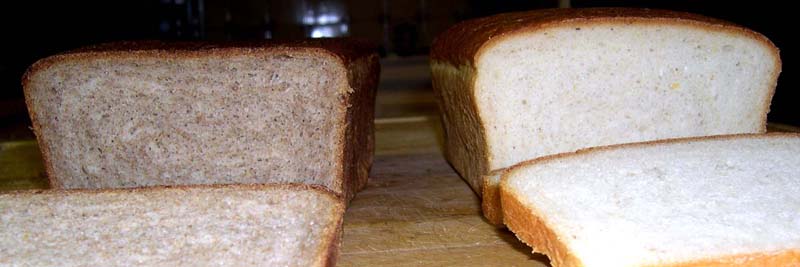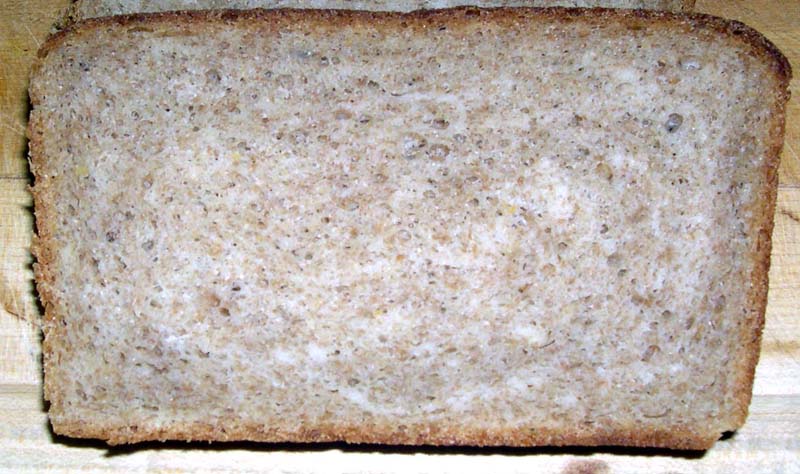I am fond of salt rising (salt risen) bread, expecially toasted for breakfast. I have found almost no instances of recipes for a whole-wheat version of this bread. Since this is an ancient technique of leavening bread, people must have used whole-wheat in the early days. I have, accordingly, devised my own recipe for this bread. The texture and crust of the two breads are very similar, as is the preparation. The flavor, however, is quite different. The whole wheat version has a milder flavor than the white version.

Whole-Wheat Salt Rising Bread -------------------------------- White Flour Salt Rising Bread
SALT RISING BREAD STARTER (TRADITIONAL)
Though NOT a sourdough bread, salt-rising bread does use a naturally occurring bacterium to make the leavening. Use the starter for either the white or the whole wheat bread. I am NOT usually an advocate for “organic” foods, but I suspect that sprouting inhibitors used on potatoes have disastrous results in making a salt-rising starter. To be on the safe side, I recommend using “organic” materials in this starter. Susan Brown has recommended eliminating the potatoes from the starter, if they are a problem. The bakers at King Arthur say there is nothing in their flour to inhibit the starter. They do not sell cornmeal.
1 or 2 medium “organically grown” Irish potatoes (4-8 oz.) peeled and thinly sliced.
4 cup (33.2 oz.) chlorine free water heated to 190°F
1/2 cup (2.5 oz.) “organic” cornmeal
1/4 cup (1.1 oz.) “organic” whole-wheat flour
1 Tbs. (0.5 oz.) sugar
1/4 tspn. baking soda
1 Tbs. (0.5 oz., 6 g) dried starter reserved from past sponges, if available.
Place the peeled and sliced potatoes in a bowl that will hold 2+ quarts. Pour on the hot water ~190°F. Sprinkle the cornmeal, whole wheat flour sugar and soda on the water and stir just to wet the ingredients. The temperature has probably dropped to ~165°F. Cover the bowl, and set in a warm (about 95 to 105°F) spot where the temperature remains fairly constant. After an hour add the dried starter, stirring slightly. Let the starter sit undisturbed for about 10 to 20 hours. The starter should have bubbles and have a strong cheese-like aroma. If you do not have bubbles and the cheese-like aroma, your starter is not active and your bread will not rise. Quit now. If the aroma is present, remove the potato slices and continue with the sponge, either white SRB or whole wheat SRB.
SALT-RISING WHOLE-WHEAT BREAD
(50% whole wheat flour, 50% white flour)
SPONGE (S. R. W. W. BREAD)
All of the above Salt Rising Starter, ~36 oz.
1 2/3 cups (14.7 oz.) scalded, tepid milk
1/4 tspn. baking soda
6 1/2 (27.6 oz.) cups whole-wheat flour
1 tspn. (0.2 oz.) sugar
Scald milk (190°F) then cool to 110°F. Pour the starter into a large mixing bowl. Stir in baking soda, milk, sugar, and whole-wheat flour, some lumps may remain. Cover with a plastic wrap and again set in a warm (95 to 105°F) place, and let the sponge rise. This may take as long as 4 hours, or as short as 1 hour. When ready, the sponge will have doubled in volume, will appear creamy, foamy, and still have the strong cheese odor. Remove about a 1/4 cup of starter and spread it out on a sheet of parchment paper to dry. When dry (about a day) break it up and store in a zippered bag for later use in a starter.
DOUGH (S. R. W. W. BREAD)
all of the above sponge, ~76 oz.
~6 1/2 cups (27.6 oz.) unbleached bread flour
1/4 cup (2.8 oz.) honey
1 1/2 Tbs. (1.0 oz.) salt
1/4 cup (2.0 oz.) melted and cooled butter
melted butter for greasing the pans and for brushing the dough
Put 3 cups of flour, 1 tspn. sugar, and 1 1/2 Tbs. salt into bowl containing the sponge, and blend. Stir in the melted butter. Then add enough flour (~3 cups, or more) to make a soft, manageable dough that you can knead.
Turn dough onto a floured surface and knead for a minute or two, adding flour as necessary. Let it rest for ten minutes. Resume the kneading until the dough is smooth adding flour as necessary. (It will not be elastic.) Divide into three loaves (about 2 lb. 1 oz. each), and shape each piece to fit 5“ x 9” loaf pans. Place each into a greased loaf pan, brush with melted butter, and cover with plastic wrap. Set loaf pans in a warm place (100 to 110°F) to rise. This final rise takes about 2 to 4 hours, and the loaves should double the original volume. Let the loaves rise until just above the top of the pan, and do not slash the loaves.
BAKING (S. R. W. W. BREAD))
Preheat oven to 450°F (with a pan of boiling water on the bottom shelf) and the middle shelf reserved for the bread pans. When the dough has risen, spray the dough with water, and place immediately into the oven. After 15 minutes reduce the oven temperature to 350°F. Bake until the interior temperature of the loaves is 195° to 200°F. There will be little or no oven spring. They should sound hollow when thumped with a finger on the bottom, about 40 minutes. It is better to over-bake than to risk under-baking. Turn out on to a cooling rack, brush with butter, and cover with a damp cloth until cooled. Bread may then be packaged and frozen.
Crumb of the 50% Whole-Wheat Salt-Rising Bread
Ford
I love salt rising bread and have been using one of Susan's recipes regularly. I love the flavor and success rate of the one that is just scalded corn meal and milk in the "risen".
I have now been inspired to try it with white whole wheat. Thanks, Terry R.
Ford,
Thanks for the recipe. I grind my own wheat and plan to try it. I love the taste of Salt Rising Bread. However, in my experiance to say the smell of the fermenting starter was "cheese-like" would be very kind. Whew!
Once I convinced my family to try the bread that resulted from those aromas, they agreed that it tasted much better than its creation smelled.
I look forward to trying your recipe.
Thanks again,
Phxdog
not only the white one (it has a creamy look), but also the WW one. Maybe this kind of starter gives a shining look to the crumb?
Nice!
I thank all of you for your comments on the WW SRB. I would like to hear from you on any results you have had in making this version of SRB or any questions you might have.
I have no idea why the flavor of this bread so different from that of the white bread. The crust and crumb of the whole-wheat bread is very similar to that of the white and to that of traditional pound cake.
I think the shining look to the crumb can be found in the other yeast breads, if one looks closely. I do not attribute it to the starter culture.
I am interested in promoting the salt-rising technique, because I think it is an almost forgotten technique and the resulting bread makes such fabulous toast. Too many of our forefathers' (and foremothers') techniques have been lost.
Ford (Rutherford B. Thompson)
The story goes that the name arose from the means of keeping the culture warm in the early days. The pan containing the culture was placed in a bed of heated rock salt in the warming space of the wood fired stove. I cannot verify this origin; it predates me.
I have used Irish (white) potatoes (also Yukon Gold, slightly yellow). Susan Brown says that you can use just the corn meal. Reinald S. Nielsen says, "A couple of years ago, after e-mail exchanges with Susan Ray Brown, I repeated the 1981 experiments with different grains (oat meal, corn grits, barley, etc.) and went on to try just about everything I could find at the local natural foods store (wheat flakes, wheat bran, rye flakes, oat bran, steel cut oats, etc.) Practical SRB starters will develop from all of them.
"Venturing further afield, I tried slivers of bark from white oak (Quercus alba) and black locust (Robinia pseudoacaca) as initiators on wheat flour with Campden; again to obtain useful starters. Next was cheddar cheese and blue cheese and, finally, flour alone. All worked."
The recipe I gave for the starter has been most reliable for me. Use whatever starter you find that works for you. Temperature is most important. Initially about 190°F to activate the spores, then about 105°F to keep them alive.
BTW, the name "Irish" potato is the came from the "potato famine" in Ireland 1845 -1849, also before my time.
Resident Conservative Curmudgeon, Ford